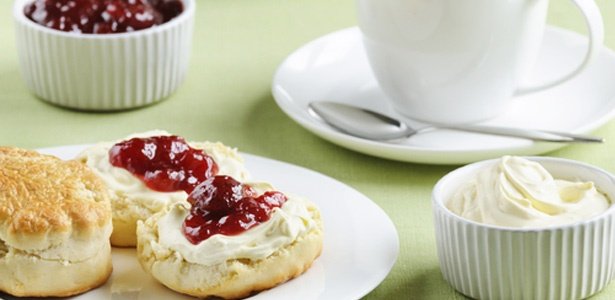Scones are one of the first things I ever learned to bake and there isn’t much that can beat a freshly baked scone with a cup of tea on a Sunday afternoon. To my sadness, establishments that offer “freshly baked” scones are often sending out pitiful lumps of dry dough that are closer to a rock cake than a true scone. Once you have experienced a GREAT scone, you will be as much of a scone-snob as I am. And really they couldn’t be easier!
The secret ingredient
For once the secret ingredient ISN’T love. It is something far more banal. Sour milk. Yes, you read that right. The more lumpy, vrot-looking the better! In these days of long-life milk I seldom actually end up with really sour lumpy milk so you can substitute buttermilk or yoghurt instead. The natural acidity of the sour milk counteracts the baking powder taste that can lead to a soapy or “fizzy” taste in the scones and because it is well cooked you don’t need to worry about any lingering lurgies.
Rubbing-in
‘Rubbing in’ is a very specific method for mixing the dry ingredients and the butter. Use cold butter and cut it into 1cm dice. With the tips of your fingers, rub the butter chunks in with the dry ingredients lifting your hands high in the air as you do it. This may well be a wives’ tale, but lifting your hands helps to incorporate air into the mixture as you rub-in. The mixture should resemble dry sea sand once it has been rubbed in, NOT a clumpy, claggy lump. If you have a lump you have most probably been a little heavy-handed or your butter was not cold when you began. This step can be performed in the food processor, on pulse but be careful as it is easy to form a lump if you process the mixture for too long.
A raincoat for the gluten
A good scone should have a “short” crumbly texture, not a tough, bread-y texture. The gluten (a protein in the flour) is developed when it is made wet and worked by kneading. The butter that you have rubbed in coats the gluten molecules with fat and in that way, prevents them from becoming really wet, like a raincoat, when you add your wet ingredients. I use a fork to mix the wet ingredients in then bring it together with my hands to form a dough.
No need to knead
For the same reason, avoid kneading your scone dough. Think of it more like “patting” into shape than hard-core bread kneading. Gently does it!
Shaping your scones and baking
Pat the dough out lightly on a floured surface. It should be soft and just slightly sticky. There is no need to roll it out with a rolling pin and don’t make it too flat or your scones will be low and flat. Pat it out to about 2cm thickness and choose a smaller round cutter – no one wants to eat a monster scone. So much more ladylike just to eat two. Cut out with a round cookie cutter dipped into flour before each cut. Lift the scone up with the cookie cutter and place it directly onto your greased tray to prevent the scones from becoming misshapen. My preference is for a smaller but taller scone so I use a 3 or 3.5cm round cutter, and this will also help the scone to form its distinctive shape allowing you to break the scone in half without cutting it. This is the hallmark of a perfect scone. Bake in a hot oven (230 °C) to ensure that they form a crisp crust but are still moist and soft inside.
Re-heating
Re-heating scones in the microwave will turn them tough and they will lose their crisp crust. If you don’t eat them straight out of the oven (although I highly recommend that you do!) you can reheat them for a few minutes in a warm oven. Scones do not last more than a day. They will become stale very quickly regardless of how they are stored or how they are reheated. They are best eaten the same day as they are made.
Accompaniments
A scone is a fairly plain mixture so jazz it up with a good quality jam and clotted cream or have them savoury with a sharp-mature Cheddar.
Aaaah… Can someone put the kettle on? Click here for the perfect scone recipe!
WATCH: How to make magic 3-ingredient scones

